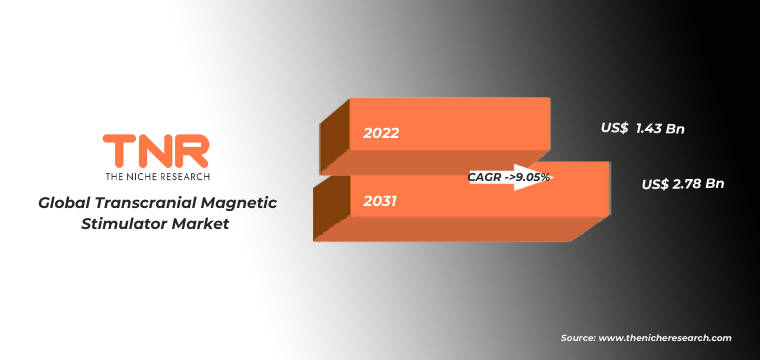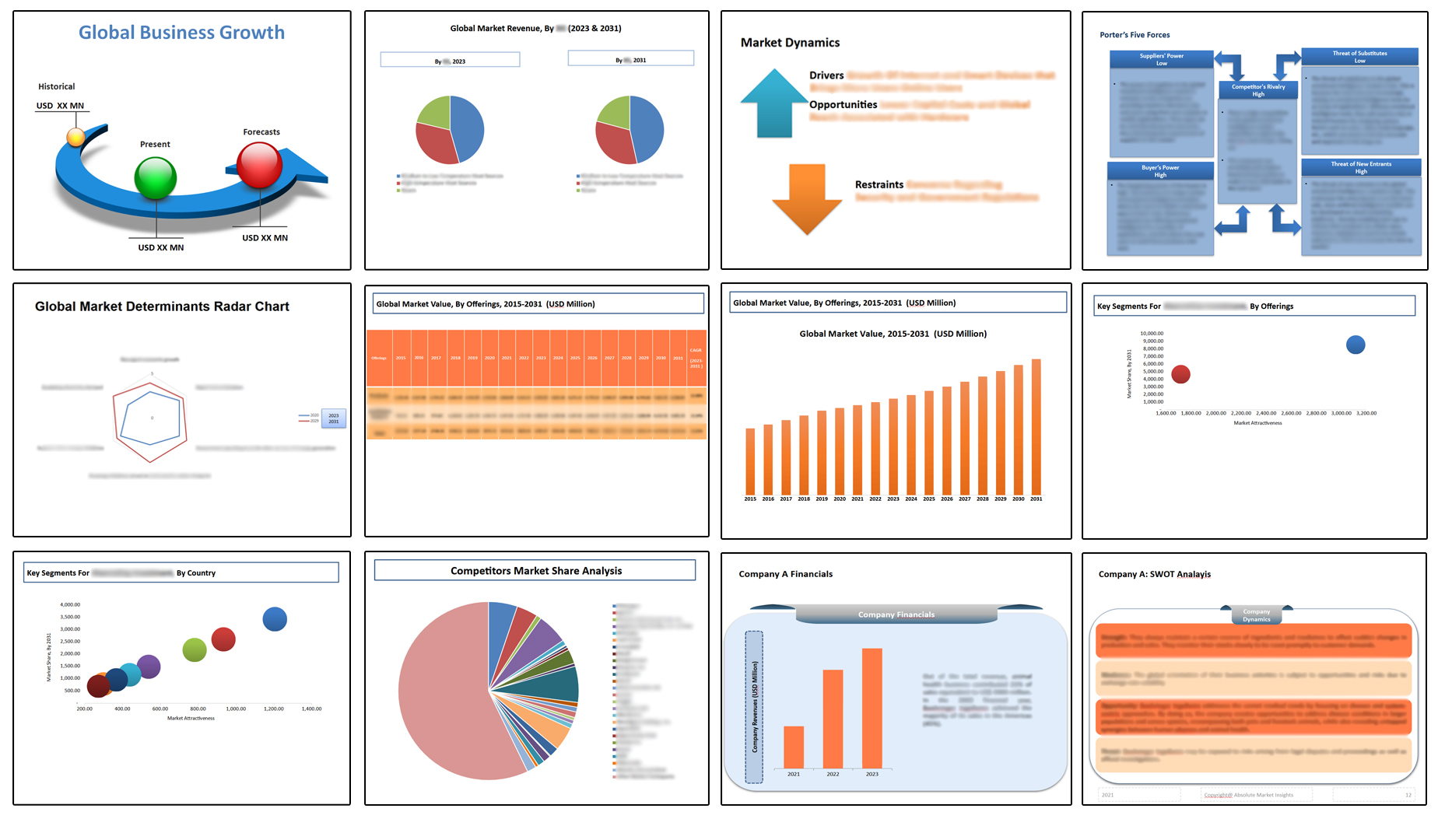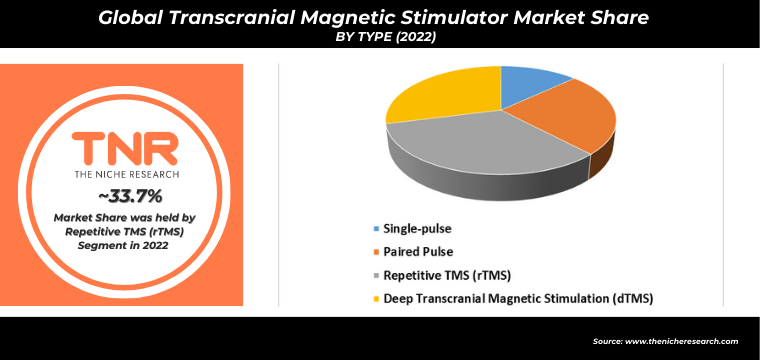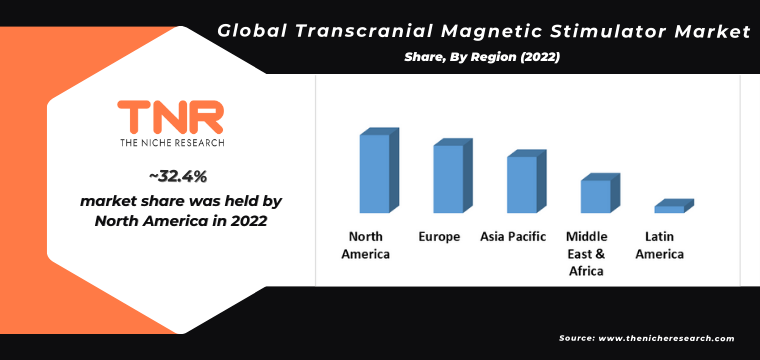Global Transcranial Magnetic Stimulator Market By Components, By Type, By Application, By Age Group, By Hz, By End Users & By Region & Segmental Forecast, 2023 – 2031
- Industry: Healthcare
- Report ID: TNR-110-915
- Number of Pages: 420
- Table/Charts : Yes
- November, 2023
- Base Year : 2024
- No. of Companies : 8+
- No. of Countries : 29
- Views : 10300
- Covid Impact Covered: Yes
- War Impact Covered: Yes
- Formats : PDF, Excel, PPT
In Terms of Revenue, Global Transcranial Magnetic Stimulator Market Reached Valuation of US$ 1.43 Bn in 2022, Projected to Achieve CAGR of 9.05% During 2023 – 2031 Global Transcranial Magnetic Stimulator Market Overview
Transcranial magnetic stimulator (TMS) market has been experiencing substantial growth in recent years due to advancements in medical technology, rising awareness about mental health, and increasing prevalence of neurological disorders. Transcranial Magnetic Stimulation (TMS) is a non-invasive medical procedure that uses electromagnetic fields to stimulate nerve cells in the brain, offering potential therapeutic benefits for various neuropsychiatric conditions. Transcranial magnetic stimulation (TMS) is gaining prominence as a promising therapeutic intervention for conditions such as depression, anxiety, schizophrenia, and even certain neurological disorders like migraines. The global transcranial magnetic stimulator market has witnessed substantial growth over the past decade, driven by increasing research activities, growing clinical evidence supporting its efficacy, and rising demand for non-invasive treatments.
Global Transcranial Magnetic Stimulator Market Revenue & Forecast, (US$ Million), 2015 – 2031 of Form
of Form
The outbreak of the COVID-19 pandemic in late 2019 had profound implications for economies, industries, and healthcare systems worldwide. The transcranial magnetic stimulator (TMS) market was no exception, experiencing both challenges and opportunities as a result of the pandemic. The transcranial magnetic stimulator market relies on a complex global supply chain for components and materials. The pandemic’s disruption to international trade and manufacturing processes led to delays and shortages in the production and distribution of TMS devices.
With patients avoiding medical facilities due to infection concerns, there was a growing interest in home-based TMS treatments. This trend prompted TMS manufacturers to consider portable and user-friendly devices for personal use. Furthermore, the pandemic’s impact on mental health brought increased attention to conditions like depression, anxiety, and PTSD. This spotlight on mental health encouraged discussions about alternative treatments like TMS.
Report Coverage and Deliverables:  Key Drivers: Several factors are fueling the growth of the transcranial magnetic stimulator market:
Key Drivers: Several factors are fueling the growth of the transcranial magnetic stimulator market:
- Rising Prevalence of Mental Health Disorders: The increasing prevalence of mental health disorders, such as depression and anxiety, is a significant driver for the transcranial magnetic stimulator TMS offers an alternative treatment option for patients who are unresponsive to traditional therapies.
- Advancements in Technology: Technological advancements in TMS devices, including improved precision, customizable treatment protocols, and enhanced patient comfort, have expanded the market’s reach and acceptance.
- Growing Research and Clinical Trials: Ongoing research and clinical trials demonstrating the effectiveness of TMS for various neurological and psychiatric disorders are boosting its adoption by healthcare providers and patients.
- Non-Invasiveness and Safety: TMS is a non-invasive procedure with minimal side effects compared to other treatment options, making it an attractive choice for both patients and clinicians.
- Increasing Investment in Mental Healthcare: Government bodies and private organizations are recognizing the importance of mental health and investing in advanced treatment options, which is positively impacting the transcranial magnetic stimulator
Evolving Landscape of the Adults’ Transcranial Magnetic Stimulator Market
Transcranial magnetic stimulator market has witnessed distinct dynamics between the segments of children and adults. The primary applications of Children’s TMS include addressing developmental disorders like attention deficit hyperactivity disorder (ADHD) and autism spectrum disorders. Research and clinical trials are ongoing to explore its efficacy and safety for paediatric use. In the realm of brain health treatments, the Adult transcranial magnetic stimulator market has experienced remarkable growth, with a surge in adoption and an evolving landscape of statistics and trends.
As a non-invasive and versatile therapeutic approach, TMS has gained traction for its potential to address various neurological and psychiatric conditions in adults. Initially focused on depression, the range of indications for Adult TMS has expanded. It now encompasses mood disorders, anxiety disorders, neurodegenerative conditions (such as Parkinson’s disease and Alzheimer’s), chronic pain management, and cognitive enhancement. Additionally, the concept of home-based transcranial magnetic stimulator market is gaining traction. This trend aims to provide patients with the convenience of receiving treatments in their own environment while adhering to prescribed protocols under remote medical supervision. The adults transcranial magnetic stimulator market segment accounted for more than 58.6% in 2022.
Thriving Transcranial Magnetic Stimulator Market in North America: A Landscape Overview
North American transcranial magnetic stimulator market boasts a substantial market share of ~40.8%, reflecting the region’s robust demand for innovative brain health solutions. The market’s value has reached significant figures, driven by factors such as clinical endorsements and patient awareness. North America is a hotspot for TMS research and innovation. Leading universities, medical centers, and private companies collaborate to advance the understanding of TMS mechanisms, refine protocols, and explore novel applications.
Regulatory agencies in North America, namely the U.S. Food and Drug Administration (FDA) & Health Canada, play a pivotal role in ensuring safety and efficacy in medical devices like TMS. Their approvals and oversight contribute to the legitimacy of TMS treatments. The North American transcranial magnetic stimulator market benefits from multidisciplinary collaborations between neuroscientists, clinicians, engineers, and data scientists. This convergence of expertise accelerates the development of innovative TMS technologies. Additionally, North America leads in the development of advanced TMS devices, incorporating features such as real-time monitoring, precision targeting, and improved patient comfort. These technological advancements drive patient satisfaction and outcomes.
Competitive Landscape
A few of the key players operating in the global transcranial magnetic stimulator market are:
- BrainsWay
- eNeura Inc.
- Magnus Medical
- Magstim
- MagVenture, Inc.
- Neuronetics
- Neurosoft
- Nexstim, Inc.
- Sebers Medical
- Other Market Participants
Report Summary of Global Transcranial Magnetic Stimulator Market
| Report Specifications | Details |
| Market Revenue in 2022 | US$ 1.43 Billion |
| Market Size Forecast by 2031 | US$ 2.78 Billion |
| Growth Rate (CAGR) | 9.05 % |
| Historic Data | 2015 – 2021 |
| Base Year for Estimation | 2022 |
| Forecast Period | 2023 – 2031 |
| Report Inclusions | Market Size & Estimates, Market Dynamics, Competitive Scenario, Trends, Growth Factors, Market Determinants, Key Investment Segmentation, Product/Service/Solutions Benchmarking |
| Segments Covered | By Components, By Type, By Application, By Age Group, By Hz, By End Users |
| Regions Covered | North America, Europe, Asia Pacific, Middle East & Africa, Latin America |
| Countries Covered | U.S., Canada, Mexico, Rest of North America, France, The UK, Spain, Germany, Italy, Nordic Countries (Denmark, Finland, Iceland, Sweden, Norway), Benelux Union (Belgium, The Netherlands, Luxembourg), Rest of Europe, China, Japan, India, New Zealand, Australia, South Korea, Southeast Asia (Indonesia, Thailand, Malaysia, Singapore, Rest of Southeast Asia), Rest of Asia Pacific, Saudi Arabia, UAE, Egypt, Kuwait, South Africa, Rest of Middle East & Africa, Brazil, Argentina, Rest of Latin America |
| Key Players | BrainsWay, eNeura Inc., Magnus Medical, Magstim, MagVenture, Inc., Neuronetics, Neurosoft, Nexstim, Inc., Sebers Medical, Other Industry Participants |
| Customization Scope | Customization allows for the inclusion/modification of content pertaining to geographical regions, countries, and specific market segments. |
| Pricing & Procurement Options | Explore purchase options tailored to your specific research requirements |
| Contact Details | Consult With Our Expert
Japan (Toll-Free): – +81 663-386-8111 South Korea (Toll-Free): – +82-808- 703-126 Saudi Arabia (Toll-Free): – +966 800 850 1643 United States: +1 302-232-5106 United Kingdom: +447537105080 E-mail: askanexpert@thenicheresearch.com
|
Global Transcranial Magnetic Stimulator MarketBy Components
- Products
-
- TMS Coils
- Stimulators
- Software
- Services
-
- Software Update
- Technical Support
- Others
- Accessories
-
- Trolley
- Control Cable
- HV Cable
- Others
By Type
- Single-pulse
- Paired Pulse
- Repetitive TMS (rTMS)
- Deep Transcranial Magnetic Stimulation (dTMS)
By Application
- Psychiatric Treatments
-
- Major Depressive Disorder
- Obsessive Compulsive Disorder
- Bipolar Disorder
- Post-Traumatic Stress Disorder
- Schizophrenia
- Smoking Cessation
- Neurological Treatments
-
- Alzheimer’s Disease
- Autism
- Chronic Pain
- Multiple Sclerosis
- Parkinson’s Disease
- Post Stroke Rehabilitation
- Others
By Age Group
- Pediatric
- Adults
- Geriatric
By Hz
- Up to 10
- Up to 50
- Up to 100
By End Users
- Hospitals and Clinics
-
- Small and Start-up Clinic
- Large and Multi-site Practices
- Research Centers
- Deep TMS Treatment Centers
- Others
By Region
- North America (U.S., Canada, Mexico, Rest of North America)
- Europe (France, The UK, Spain, Germany, Italy, Nordic Countries (Denmark, Finland, Iceland, Sweden, Norway), Benelux Union (Belgium, The Netherlands, Luxembourg), Rest of Europe)
- Asia Pacific (China, Japan, India, New Zealand, Australia, South Korea, Southeast Asia (Indonesia, Thailand, Malaysia, Singapore, Rest of Southeast Asia), Rest of Asia Pacific)
- Middle East & Africa (Saudi Arabia, UAE, Egypt, Kuwait, South Africa, Rest of Middle East & Africa)
- Latin America (Brazil, Argentina, Rest of Latin America)
Table of Contents
**Exclusive for Multi-User and Enterprise User.
Global Transcranial Magnetic Stimulator MarketSegmentation
By Components
By Type
By Application
By Age Group
By Hz
By End Users
By Region
**Note: The report covers cross-segmentation analysis by region further into countries
The Niche Research approach encompasses both primary and secondary research methods to provide comprehensive insights. While primary research is the cornerstone of our studies, we also incorporate secondary research sources such as company annual reports, premium industry databases, press releases, industry journals, and white papers.
Within our primary research, we actively engage with various industry stakeholders, conducting paid interviews and surveys. Our meticulous analysis extends to every market participant in major countries, allowing us to thoroughly examine their portfolios, calculate market shares, and segment revenues.
Our data collection primarily focuses on individual countries within our research scope, enabling us to estimate regional market sizes. Typically, we employ a bottom-up approach, meticulously tracking trends in different countries. We analyze growth drivers, constraints, technological innovations, and opportunities for each country, ultimately arriving at regional figures.Our process begins by examining the growth prospects of each country. Building upon these insights, we project growth and trends for the entire region. Finally, we utilize our proprietary model to refine estimations and forecasts.
Our data validation standards are integral to ensuring the reliability and accuracy of our research findings. Here’s a breakdown of our data validation processes and the stakeholders we engage with during our primary research:
- Supply Side Analysis: We initiate a supply side analysis by directly contacting market participants, through telephonic interviews and questionnaires containing both open-ended and close-ended questions. We gather information on their portfolios, segment revenues, developments, and growth strategies.
- Demand Side Analysis: To gain insights into adoption trends and consumer preferences, we reach out to target customers and users (non-vendors). This information forms a vital part of the qualitative analysis section of our reports, covering market dynamics, adoption trends, consumer behavior, spending patterns, and other related aspects.
- Consultant Insights: We tap into the expertise of our partner consultants from around the world to obtain their unique viewpoints and perspectives. Their insights contribute to a well-rounded understanding of the markets under investigation.
- In-House Validation: To ensure data accuracy and reliability, we conduct cross-validation of data points and information through our in-house team of consultants and utilize advanced data modeling tools for thorough verification.
The forecasts we provide are based on a comprehensive assessment of various factors, including:
- Market Trends and Past Performance (Last Five Years): We accurately analyze market trends and performance data from preceding five years to identify historical patterns and understand the market’s evolution.
- Historical Performance and Growth of Market Participants: We assess the historical performance and growth trajectories of key market participants. This analysis provides insights into the competitive landscape and individual company strategies.
- Market Determinants Impact Analysis (Next Eight Years): We conduct a rigorous analysis of the factors that are projected to influence the market over the next eight years. This includes assessing both internal and external determinants that can shape market dynamics.
- Drivers and Challenges for the Forecast Period:Identify the factors expected to drive market growth during the forecast period, as well as the challenges that the industry may face. This analysis aids in deriving an accurate growth rate projection.
- New Acquisitions, Collaborations, or Partnerships: We keep a close watch on any new acquisitions, collaborations, or partnerships within the industry. These developments can have a significant impact on market dynamics and competitiveness.
- Macro and Micro Factors Analysis:A thorough examination of both macro-level factors (e.g., economic trends, regulatory changes) and micro-level factors (e.g., technological advancements, consumer preferences) that may influence the market during the forecast period.
- End-User Sentiment Analysis: To understand the market from the end-user perspective, we conduct sentiment analysis. This involves assessing the sentiment, preferences, and feedback of the end-users, which can provide valuable insights into market trends.
- Perspective of Primary Participants: Insights gathered directly from primary research participants play a crucial role in shaping our forecasts. Their perspectives and experiences provide valuable qualitative data.
- Year-on-Year Growth Trend: We utilize a year-on-year growth trend based on historical market growth and expected future trends. This helps in formulating our growth projections, aligning them with the market’s historical performance.
Research process adopted by TNR involves multiple stages, including data collection, validation, quality checks, and presentation. It’s crucial that the data and information we provide add value to your existing market understanding and expertise. We have also established partnerships with business consulting, research, and survey organizations across regions and globally to collaborate on regional analysis and data validation, ensuring the highest level of accuracy and reliability in our reports.









